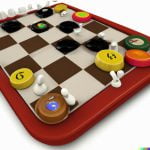Are you ready to step back in time and experience the excitement of classic Major League Baseball? The Classic Major League Baseball Board Game, with its 1990 ruleset, offers a nostalgic glimpse into the world of tabletop sports simulation. This beloved game has stood the test of time, captivating generations of baseball fans with its immersive gameplay and strategic depth.
First introduced in 1962, the Classic Major League Baseball Board Game quickly gained popularity and became a staple in the homes of sports enthusiasts. The 1990 edition marked a significant milestone in the game’s evolution, introducing new rules and mechanics that added a fresh layer of complexity to gameplay. Understanding these rules is crucial for anyone looking to fully immerse themselves in the authentic experience of playing this classic game.
In this article, we will delve into the historical significance of the Classic Major League Baseball Board Game and explore the specific rules and gameplay mechanics introduced in the 1990 edition. Whether you’re a seasoned veteran or new to the game, our step-by-step guide will help you set up and play using the 1990 rules.
Additionally, we’ll provide valuable strategy tips based on these rules and showcase some iconic player cards from this edition. Join us as we embark on a journey through time to uncover the legacy and influence of this timeless tabletop classic.
Overview of the 1990 Rules
The Classic Major League Baseball Board Game 1990 edition featured specific rules and gameplay mechanics that added depth and excitement to the gaming experience. Here is an overview of the key elements that made the 1990 edition unique:
- Pitching Mechanics: In the 1990 edition, pitching was a crucial aspect of the game. Each pitcher card had different ratings for fastball, curveball, slider, and changeup, requiring players to strategically choose their pitches based on the batter’s strengths and weaknesses.
- Batting Dynamics: The 1990 edition introduced a new batting system that took into account a batter’s average, power, and ability to hit to all fields. This added a layer of realism as players had to consider each batter’s strengths and adjust their strategy accordingly.
- Fielding Strategies: Fielding in the 1990 edition was not just about making routine plays. The game incorporated defensive positioning and player range, allowing players to make strategic decisions on where to position their fielders based on the hitting tendencies of their opponent.
These specific rules and gameplay mechanics made the 1990 edition of the Classic Major League Baseball Board Game an immersive and strategic experience for tabletop gaming enthusiasts. The attention to detail in simulating real baseball dynamics added depth and complexity to the game, setting it apart from earlier versions.
Overall, the 1990 edition brought a new level of realism and strategy to the Classic Major League Baseball Board Game. These specific rules and gameplay mechanics enhanced the overall gaming experience, making it a beloved classic among tabletop gamers even today.
How to Play
The Classic Major League Baseball Board Game has been a beloved tabletop game for baseball enthusiasts since its introduction. The 1990 edition of the game is especially cherished for its detailed player cards and strategic gameplay. For those who are new to the game or need a refresher, here is a step-by-step guide on how to set up and play the Classic Major League Baseball Board Game using the 1990 rules.
To begin, gather the game board, player cards, dice, and any other necessary components. Each player should choose a team and select their corresponding player cards. The game board should be placed in the center of the playing area, with each player sitting across from each other.
Next, determine which player will be the home team and which will be the visiting team. The home team will have the advantage of batting second. Place the appropriate line-up cards in front of each player based on their chosen team.
After setting up the game board and selecting teams, it’s time to start playing. Roll the dice to determine outcomes for each at-bat and fielding play. Use the player cards to keep track of statistics and make strategic decisions throughout the game. Follow the specific rules for pitching, hitting, base running, and fielding as outlined in the 1990 edition rulebook to ensure fair gameplay.
By following these steps and familiarizing yourself with the 1990 rules, players can experience all the excitement and strategy that comes with playing Classic Major League Baseball Board Game. It’s a fantastic way to immerse yourself in America’s favorite pastime while enjoying friendly competition with friends or family.
Key Differences From Previous Versions
The 1990 edition of the Classic Major League Baseball Board Game introduced several notable changes and improvements compared to earlier versions, making it a standout entry in the history of the game. One significant change was the addition of more detailed player cards, allowing for a more realistic and immersive gameplay experience. The cards included statistics such as batting average, home runs, and RBIs, providing players with a more accurate representation of their favorite baseball stars.
In addition to the enhanced player cards, the 1990 edition also featured an updated pitching mechanic. Instead of using dice rolls to determine pitch outcomes, players now had the option to make strategic decisions based on pitcher fatigue and individual player statistics. This added element of strategy brought a new level of depth to the game, allowing for more nuanced and realistic gameplay.
Another key improvement in the 1990 edition was the introduction of updated team rosters and player ratings, reflecting the changes that had occurred in Major League Baseball at that time. This allowed fans to recreate their favorite matchups and rivalries from the 1990 season with greater accuracy than ever before.
Overall, these changes helped solidify the 1990 edition as a standout entry in the Classic Major League Baseball Board Game series, setting it apart from its predecessors with its enhanced realism and strategic depth.
Modernized Game Mechanics
One notable change in the 1990 edition was the modernization of game mechanics that reflected advancements in tabletop gaming at that time. The introduction of detailed player cards and updated pitching mechanics brought a new level of sophistication to gameplay, catering to both casual fans and seasoned tabletop gamers.
Updated Team Rosters
The 1990 edition featured updated team rosters and player ratings that accurately reflected Major League Baseball’s landscape at that time. This attention to detail allowed players to recreate historic matchups with a high degree of authenticity, capturing the essence of the 1990 baseball season within a tabletop gaming experience.
Enhanced Realism
Overall, the key differences in the 1990 edition contributed to an overall sense of enhanced realism within the game. From individual player statistics to strategic pitching decisions, these improvements aimed to provide players with an immersive and authentic representation of America’s favorite pastime.
Strategy Tips
The Classic Major League Baseball Board Game from 1990 comes with a set of rules that require both skill and strategy to master. Here are some key tips and tricks for players looking to gain an edge over their opponents using the 1990 ruleset.
First and foremost, it’s essential to familiarize yourself with the strengths and weaknesses of each team in the game. Every team has standout players as well as areas where they may be more vulnerable. Understanding these aspects can help you make informed decisions when managing your team and making crucial plays during the game.
Another important strategy is to pay close attention to player statistics and card values. Analyzing these details can give you valuable insights into which players are best suited for specific situations, such as hitting, pitching, or fielding. By utilizing this knowledge effectively, you can optimize your gameplay and increase your chances of success on the field.
Lastly, don’t underestimate the value of strategic decision-making during gameplay. Whether it’s deciding when to steal a base, switch pitchers, or go for a high-risk/high-reward play, being able to think ahead and anticipate your opponent’s moves can give you a significant advantage in the game.
| Strategy Tip | Description |
|---|---|
| Know Your Team | Understanding each team’s strengths and weaknesses is crucial for making informed decisions during gameplay. |
| Analyze Player Statistics | Utilize player statistics and card values to strategically choose the best players for different game situations. |
| Strategic Decision-Making | Anticipating opponent moves and making strategic decisions during gameplay can provide a significant advantage. |
Notable Player Cards
Iconic Players From the 1990 Edition
The 1990 edition of the Classic Major League Baseball Board Game featured an array of iconic player cards that left a lasting impact on gameplay. Some of the most notable players included Ken Griffey Jr. Nolan Ryan, Barry Bonds, and Cal Ripken Jr. Each player card not only reflected the real-life skills and abilities of these baseball legends, but also added an extra layer of strategy to the game.
These player cards were highly sought after by players due to their significant impact on gameplay dynamics.
Impact on Gameplay
Each player card in the 1990 edition had unique attributes that affected various aspects of gameplay. For example, pitcher cards like Nolan Ryan had high strikeout ratings, making them effective at shutting down opposing batters.
On the other hand, hitters like Ken Griffey Jr. possessed powerful hitting statistics which made them valuable assets in scoring runs. The presence of these iconic player cards added excitement and strategic depth to every game, as players had to carefully consider how to utilize and counteract the strengths and weaknesses of each card.
Collectible Aspect
The inclusion of iconic player cards in the 1990 edition also contributed to the collectible aspect of the game. Fans and collectors eagerly sought out specific player cards to add to their collection, leading to a vibrant trading community within the board gaming community. This further enhanced the overall appeal of the Classic Major League Baseball Board Game, turning it into more than just a tabletop experience but also a hobby for passionate fans of both baseball and board games.
Legacy and Influence
In conclusion, the Classic Major League Baseball Board Game has left a lasting impact on tabletop gaming, particularly with the release of its 1990 rules edition. The game’s historical significance cannot be understated, as it has become a beloved classic among board game enthusiasts and baseball fans alike. Its influence on modern tabletop gaming is evident, as it paved the way for more sports-themed board games and introduced innovative gameplay mechanics that have since become industry standards.
The 1990 rules edition of the Classic Major League Baseball Board Game introduced several key differences and improvements compared to earlier versions, further cementing its legacy in the tabletop gaming world. From updated player cards to refined gameplay strategies, the 1990 edition remains a favorite among collectors and players looking to experience the nostalgia of classic board games.
As we continue to celebrate the legacy of the Classic Major League Baseball Board Game and its impact on modern tabletop gaming, it is important to recognize how it has brought joy and entertainment to countless individuals over the years. Whether reliving iconic baseball moments or engaging in strategic gameplay, this timeless classic continues to captivate players of all ages and will forever hold a special place in the history of board gaming.
As new generations discover the thrill of playing this historic game, its influence will continue to be felt for years to come.
Frequently Asked Questions
How Many Innings Must Be Played for a Major League Baseball Game to Be Official?
In Major League Baseball, a game becomes official after 5 innings have been completed, or 4.5 innings if the home team is winning. This means that if a game is called off due to weather or other reasons before completing this minimum number of innings, it would be considered a “no game” and would need to be rescheduled.
What Are the Rules for the Card Game Baseball?
The card game Baseball is typically played with a standard deck of playing cards and follows rules that mimic the sport of baseball. Each suit represents an inning, and players try to score runs by drawing cards from the deck, with certain cards representing hits, outs, walks, etc.
It’s a fun and light-hearted game that can be enjoyed by people of all ages.
What Is Stratomatic Baseball?
Stratomatic Baseball is a simulation-based strategy game that allows players to manage their own baseball teams using real-life player statistics. It’s popular among baseball fans who enjoy analyzing player performances and making strategic decisions about lineup choices, player substitutions, and in-game tactics.
The game has been around for decades and continues to attract dedicated fans who appreciate its complexity and realism.

I love playing all kinds of games – from classics like Monopoly to modern favourites like Ticket to Ride.
I created this blog as a way to share my love of board games with others, and provide information on the latest releases and news in the industry.





